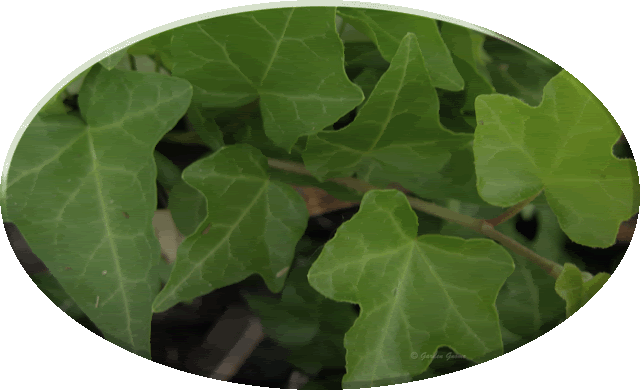
English Ivy
(Hedera helix)
I have a somewhat small patch of
English Ivy (Hedera helix) growing along the south side of the house originally planted to hide a gas line. I'm taking several clippings of this plant to our new house. This versatile evergreen ivy can be grown as a houseplant or outdoors. When grown outdoors, English Ivy can be used as a maintenance free ground cover, climbing vine or in a hanging basket. It can climb as high as fifty feet, attaching itself to wood and brick via aerial rootlets. English Ivy provides summer shading when grown as a climber on the south side of the house and when grown on lattice can create privacy screening. The climbing nature of English Ivy makes this an ideal plant for hiding unattractive but necessary pipes on the outside of houses. It can mask an ugly wall with its beautiful greenery. This ivy grows well in shady making it ideal for problem areas like under trees. The vigorous and dense growth pattern of English Ivy also make this plant ideal for weed and erosion control. The plant also does well in sunny locations. With all the benefits English Ivy offers, what are the negatives and why do some people want to rid their properties of this plant?
What some people consider beneficial plants others view them as weeds. So it is with English Ivy. This plant is listed by Oregon and Washington (cultivars: Baltica', 'Pittsburgh', 'Star') as a noxious weed. It is considered aggressive, invasive and introduced species to North America. Concerns regarding this ivy as indicated by
No Ivy League are that this plant results in monocultures that provide no habitats for indigenous wildlife. However, I do not agree with this opinion. When grown as a ground cover, English Ivy provides cover and habitats for small rodents, toads, frogs and snakes. More than one a toad or snake has scurried out of my little patch. When grown as a climber, English Ivy provides a safe haven for smaller birds. If you watch a patch of this ivy grown up the side of a house, it isn't long before smaller birds like the
House Finch (Carpodacus mexicanus) are seen flitting in and out of the ivy. This bird originated in the southern US and Mexico making it indigenous to North America. It has since spreed throughout the United States and southern parts of Canada. Their nests are about three and a half inches in diameter easily making English Ivy an ideal spot for nesting. The berries provide food for birds as well. English Ivy also provides a habitat for insects including beneficial insects for the garden.
Since English Ivy can become a habitat for rodents, insects and snakes some precaution should be taken when using this plant as a climber on the outside of a house. While it does look very pretty covering a wall and softening the window edges, it's best to be sure you have good screening to prevent insects from getting indoors. You may also have to spray for spider and mosquito control something that when growing organically as I do is avoided unless absolutely necessary and then on non-edible plants only. To prevent problems with rodents keep the ivy trimmed at the bottom, effectively removing the rodent habitat. One further problem with English Ivy grown on a house is the aerial roots attach to the wood siding or brick. Removal of the vine leaves marks on either. It can present problems on brick walls with loose mortar can be seriously damaged by English Ivy as well.
English Ivy despite it's problem can be a beneficial plant. The invasive nature of English Ivy can be kept in check by pruning. The berries are poisonous for humans so be sure to keep an eye on children around this plant. It should not be planted in areas where the invasiveness could cause problems or climbing nature can cause problems. English Ivy should be pruned to prevent leaf spot. Mites can be controlled using insecticidal soap. Other than these problems, English Ivy is rather problem free.
English Ivy is easily propagated by cuttings. Simply cut an end piece about four or five inches long then place the cut end in water. New roots will appear in a few days ready for planting either indoors or outdoors. A mature English Ivy plant produces berries that birds eat thus spreading the seeds for new plants or you could plant the seeds yourself.
I will be planting my English Ivy both inside and outside. The new house is bricked so I doubt my husband will want it planted as a climber even though it would give the front of the house (facing away from the water) a cute, English cottage appearance. I plan to use it outdoors in hanging baskets and possibly as ground cover depending on what I find in the gardens when we get moved in. For now the English Ivy cuttings are happily forming roots in a container of water.
Happy Gardening!
Garden Gnome
©2007
 My garden here as I knew is is no more and may cease to exist entirely after the new owners take possession of the house. This garden gave me much more than I could even begin to put into words. It was such a learning experience in all aspects. I have so many memories and pictures of this garden so it will live on in my mind, in our family discussion and in the scrapbooks. It will also live on through the occasional post on this blog when I'm not talking about my new gardens. So I bid this garden a fond farewell. I hope it lives on to bring happiness and joy to the new owners and if it doesn't it can rest easy knowing how much it brought to us. Oh and I should mention the gnomes, fairies and other mystical inhabitants in this garden have decided to move with us so all is well.
My garden here as I knew is is no more and may cease to exist entirely after the new owners take possession of the house. This garden gave me much more than I could even begin to put into words. It was such a learning experience in all aspects. I have so many memories and pictures of this garden so it will live on in my mind, in our family discussion and in the scrapbooks. It will also live on through the occasional post on this blog when I'm not talking about my new gardens. So I bid this garden a fond farewell. I hope it lives on to bring happiness and joy to the new owners and if it doesn't it can rest easy knowing how much it brought to us. Oh and I should mention the gnomes, fairies and other mystical inhabitants in this garden have decided to move with us so all is well.








 My Vegetable Garden
My Vegetable Garden

















